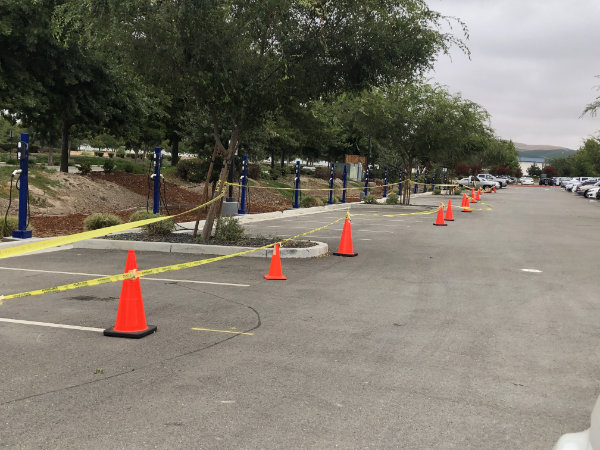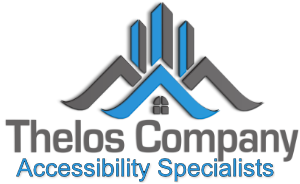
Let’s start with some California Building Code definitions
ELECTRIC VEHICLE CHARGING STATION (EVCS).One or more electric vehicle charging spaces served by an electric vehicle charger or other charging equipment. Where a multiport electric vehicle charger can simultaneously charge more than one vehicle, the number of electric vehicle charging stations shall be considered equivalent to the number of electric vehicles that can be simultaneously charged.
ELECTRIC VEHICLE (EV). [DSA-AC & SFMJ An automotive-type vehicle for on-road use, such as passenger automobiles, buses, trucks, vans, neighborhood electric vehicles, electric motorcycles, and the like, primarily powered by an electric motor that draws current from a rechargeable storage battery, fuel cell, photovoltaic array, or other source of electric current. Plug-in hybrid electric vehicles (PHEV) are considered electric vehicles. For the purpose of this code, off road, self-propelled electric vehicles, such as industrial trucks, hoists, lifts, transports, golf carts, airline ground support equipment, tractors, boats, and the like, are not included.
DRIVE-UP ELECTRIC VEHICLE CHARGING STATION. An electric vehicle charging station in which use is limited to 30 minutes maximum and is provided at a location where the electric vehicle approaches in the forward direction, stops in the vehicle space, charges the vehicle, and proceeds forward to depart the vehicle space. The arrangement of a drive-up electric vehicle charger and its associated vehicle space is similar to a gasoline filling station island.
If you are altering solely for the purpose of installing EVCS at facilities where vehicle refueling, recharging, parking or storage is the primary function then you may be required to comply with Path of Travel improvements. This is extremely important because you may be obligated to do up to 20%, if you are below the valuation threshold, in Path of Travel improvements above and beyond your scope of work. Read more about valuation threshold.
The General Accessibility Requirements for Electric Vehicle Charging Stations are critical prior to any installation because they specify quantities, configurations, specific requirements and exceptions.
- Electric Vehicle Charging Stations will be installed per 11B-812 (technical installation requirements)
- When you add EVCS to an existing facility only the new EV chargers and alterations to existing EV chargers are required to comply with 11b-812
- The electric vehicle charging stations must comply with the Operable Parts technical section which requires one hand operation with no grasping, pinching or twisting.
- EVCS have an exception to the 5 pound max operating force requirement
- Minimum numbers of electric vehicle charging stations is determined by the number at any one facility within a site. If you have multiple facilities within a site they are calculated individually. Check the definition of an EVCS.
- Minimum numbers do not apply to facilities that are not intended for public use. For instance, facilities provided for specific fleet vehicles or individuals. See the image on this page.
- In public housing this section does not apply to an EV owner or operator at their own residence.
- Public or Common use EVCS shall comply with section 11B-812 in accordance with Table 11B-228.3.2.1 which stipulates how many of each type of space is required and at what threshold. Use this to see how many of each type of EV charging spaces you need.
- ALL drive up electric vehicle charging stations must comply with 11B-812
Electric Vehicle Charging Stations EVCS California Building Code 11B-812
Here are the technical accessible requirements in a short, general and condensed version. Consult CBC 11B-812 for greater detail and accuracy.
- When measuring dimensions of EVCS spaces measure to center line if another space is adjacent or to the outer edge if no other space is adjacent.
- Must meet operable parts requirements such as pinching, gripping, twisting and so forth.
- Floor and ground space at space and access aisle will be level to within 1:48. No changes in slope or detectable warnings in the space or access aisle.
- There must be a vertical clearance of 98 inches at the space, access aisle and the vehicular path that serves them.
- EVCS will be on an accessible route to the building they serve or accessible route to the accessible pedestrian entrance of the EV charging facility if they do not serve a particular building.
- An accessible route will connect the EV charger with the vehicle space it serves.
- A curb, wheel stop or other device will be provided to prevent the vehicle form encroaching on adjacent accessible routes.
- Vehicle spaces and access aisles shall be arranged so that users are not required walk behind a vehicle space or vehicle other than their own, however ambulatory EVCS shall not be required to comply and spaces installed at existing facilities shall comply to the maximum extent feasible.
- EVCS shall be designed to not obstruct accessible routes with cables or other element
- EVCS vehicle spaces shall be 216 inches long except when the vehicle space is parallel to the vehicular way or at drive up EV chargers it will be 240 inches long.
- Van accessible spaces shall be 144 inch minimum wide and adjacent to an access aisle on the passenger side.
- Standard accessible vehicle space shall be a minimum of 108 inches wide and shall be adjacent to an access aisle.
- Ambulatory spaces shall be a minimum of 120 inches wide and shall not be required to be adjacent to an access aisle.
- Drive up vehicle spaces shall be 204 inches wide minimum and shall not be required to be adjacent to an access aisle.
- Access aisles shall be a minimum of 60 inches wide and may serve 2 vehicle spaces, they shall also extend the full length of the vehicle space they serve
- Access aisles may not overlap the vehicular way. The access aisle may be on either side of of the vehicle space except for van accessible spaces.
- Access aisles will be marked with a contrasting color other than the blue used for accessible parking spaces. It shall also be marked with hatched lines at a maximum of 36 inches.
- 12 inch high NO PARKING shall mark each access aisle and shall be visible form adjacent vehicular way.
- Where 4 or fewer total electric vehicle charging stations are provided identification with ISA International Symbol of Accessibility is not required.
- Where 5 to 25 EVCS are provided only the van accessible space requires ISA identification.
- Where 26 or more EV chargers are provided the van and standard vehicle spaces will be identified.
- Ambulatory spaces will not be required to be marked.
- Drive up electric vehicle charging stations shall not be required to be marked.
- When provided identification signs will be reflectorized and a minimum 70 square inches
- Identification signs shall visible from the space they serve. Signs identifying van accessible spaces shall read “van accessible”. Signs shall be permanent and 60 inches above ground surface and 80 inches above ground surface when in the circulation path.
- Electric Vehicle Charging Stations vehicle spaces will be surface marked with “EV Charging Only” in 12 inch high letters aligned with the end of the parking space and centered.
- Operable parts will comply with twisting, grasping and pinching requirements.
- Point of sale devices will comply with their respective code sections.
- EV chargers shall be within the projected width or adjacent to the vehicle space they serve. Electric Vehicle Chargers serving more than one space shall be within the combined vehicle space width. In alterations the EV charger may be within the projected width of the access aisle and within 36 inches of head of the space. Where the vehicle space is parallel to the vehicular way the EV Charger shall be with 48 inches of the head or foot of the space.

